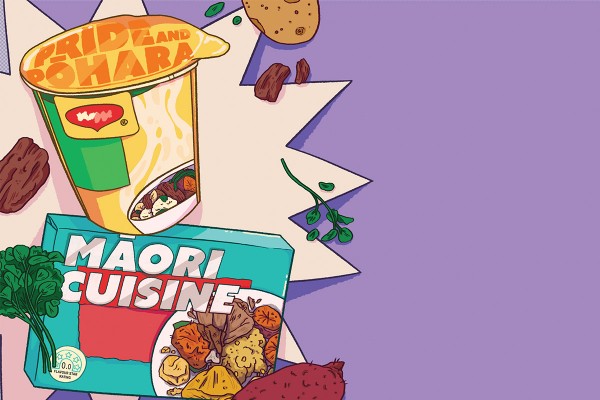Let’s cut the crap. Aotearoa New Zealand loves to brag about ‘authentic’ Māori cuisine like hāngī, boil-up, fried bread, and steamed pudding. But the uncomfortable truth is: these aren’t traditional, authentic Māori dishes. They’re struggle meals that emerged during the colonial era, when Europeans pushed Māori into poverty, compelling us to innovate and adapt to survive.
The reality is that many of these so-called traditional dishes were born out of necessity and survival. When the English arrived, they didn’t just steal land, but resources and freedom too, and both our cuisine and the land still bear the marks of this today. Māori had to make do with what was available, creating meals from off-cuts of meat, wild greens, and simple carbs – basic, filling, and designed to sustain hard-working communities through tough times. Far from flourishing culinary ventures, these were acts of survival.
The epic transformation of these humble dishes into widely celebrated cultural cuisine gives rise to important questions about authenticity and cultural preservation. When did hardship become so intertwined with our heritage? Why do we continue to romanticise it? And why are we so protective of ‘tradition’ instead of embracing flexibility?
Take hāngī, the OG air fryer, for instance. While the cooking method itself is almost ancient, the ingredients we now associate with it – like pork, potatoes, and cabbage – were all introduced by Europeans. Boil-up is another example; just a pot of basically whatever meat and vegetables could be scrounged together. As a Northland gewl, I grew up in a whānau who poured heavy cream in boil-up broth but was quick to pounce on people whose go-to mix-up included sausages. It didn’t matter whether they were the fancy Aussie Butcher chicken and rosemary ones, Sizzlers, or Cheerios – our noses immediately turned up. For us, it just seemed improper. But we were also putting down whānau who relied on the cheap, bulk buys.
It’s giving… tone deaf.
And it seems to be a universal approach. A fried bread recipe hits TikTok and the food police swarm in. They debate in the comment section over technicalities; how yeast turns it into a doughnut, or how sugar water is just straight-up “blasphemous”. Then there are the purists who preach that you must “use pūhā because cabbage isn’t traditional,” simultaneously drowning their boil-up in tomato sauce. And don’t even get me started on the ridiculous grading matrix for what makes a “good” hāngī. There must be three types of meat, every root vegetable with stuffing, fried bread with REAL butter. And you mustn't forget a drink – but not for more than $10. Skip the umu and you’re a traitor, but too much earthy seasoning (dirt) and you’ve ruined it.
As a seasoned hāngī-maker and fried-bread-fanatic, I’ve heard it all before. The soaring criticisms and demanding expectations are enough to make you toss the tea towel altogether. It’s as though we’ve lost sight of the entire point of these meals and their appeal. My point is, e te iwi: we’re clinging to traditions that never were. Our ancestors wouldn’t recognise half of the spread on the table, so how can one be so protective of a fabrication? Hongi Hika probably wouldn't give a second thought on whether a potato salad was warm or cold.
Confronting these attitudes often falls between the lines of “you better not” and “how dare you.” But the reality is that our kai is central to whānau because of the flexibility that comes with it. There aren’t actually any rules to making a hāngī, though it’s implied through the cooking method. Boil-up has always been quick cuts in any old pot for a fast meal, and you really can’t overdo fried bread; it's almost foolproof – and it’s certainly got more heart than instant noodles. This isn’t to say that the traditions that develop aren’t important. Most families have their own way of doing things and I’ve gotten a few growlings at home for straying from our usual methods. Mum’s favourite line “don’t tutu with the food” never gets old… at least, until we get sick of the unseasoned hāngī vegetables. To my whānau: if your tūpuna can fight at Kororāreka, you can try some rosemary.
The question remains: why are we so damn eager to present kai that originated from struggle meals as proud symbols of our culture? It may be that it’s a complex mix of nostalgia, resilience, and a desire to reclaim our narrative. In doing so, however, we risk glossing over the harsh realities that shaped these dishes. When we put such a whole-hearted claim on – let’s be honest, here – pretty bland meals and then rave about them to ngā hau e whā, it paints a particular image of where we’re at. Yes, let’s celebrate the real legacy of Māori cuisine: our ancestors’ ingenuity, the resilience, and the strength in the ability to make something out of nothing. But let’s also do better to not whakaiti our fellow Māori for how they make their fried bread. Even if they use sugar water.



